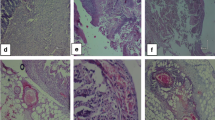Abstract
Purpose
The aim of this study was to evaluate the complication rates and inflammatory response in TachoSil™-sealed small-diameter anastomoses with conventional and reduced suture number as a model for neonatal bowel surgery.
Methods
Ileo-ileal anastomoses were performed in 73 rats. In the control group, the anastomosis was accomplished with the conventional technique, using nine interrupted sutures. In the other groups with nine, six, and three interrupted sutures, the anastomotic line was additionally sealed with a fibrin-coated collagen patch (TachoSil™). The rats were sacrificed on days 0, 2, and 10. Clinical and functional parameters included the rates of ileus, insufficiency and death, operating time, adhesions, bursting pressure, and preanastomotic dilatation. The histological examination of the anastomoses concentrated on assessing the inflammatory cell infiltration of the TachoSil™ patch and the intestinal wall.
Results
Severe preanastomotic dilatation was observed in additionally sealed ileo-ileal anastomoses with conventional suture number and high complication rates (ileus, perforation, death) occurred in additionally sealed anastomoses with reduced suture number. We found a massive microabscess-forming inflammation in additionally sealed anastomoses. Inflammatory cell infiltration was highest in the collagen layer of the sealing patch (p < 0.05 vs. fibrin layer of the sealing patch and vs. intestinal wall).
Conclusions
As a result of our findings, additional sealing of small-diameter intestinal anastomoses with TachoSil™ cannot be recommended.





Similar content being viewed by others
References
Rygl M, Novotna J, Herget J, Skaba R, Snajdauf J (2009) Parameters of healing in approximative intestinal anastomosis. Eur J Pediatr Surg 19:25–29
Nordentoft T, Rømer J, Sørensen M (2007) Sealing of gastrointestinal anastomoses with a fibrin glue-coated collagen patch: a safety study. J Invest Surg 20:363–369
Stumpf M, Junge K, Rosch R, Krones C, Klinge U, Schumpelick V (2009) Suture-free small bowel anastomoses using collagen fleece covered with fibrin glue in pigs. J Invest Surg 22:138–147
Frilling A, Stavrou GA, Mischinger HJ, de Hemptinne B, Rokkjaer M, Klempnauer J, Thörne A, Gloor B, Beckebaum S, Ghaffar MF, Broelsch CE (2005) Effectiveness of a new carrier-bound fibrin sealant versus argon beamer as haemostatic agent during liver resection: a randomised prospective trial. Langenbecks Arch Surg 390:114–120
Anegg U, Lindenmann J, Matzi V, Smolle J, Maier A, Smolle-Jüttner F (2007) Efficiency of fleece-bound sealing (TachoSil) of air leaks in lung surgery: a prospective randomised trial. Eur J Cardiothorac Surg 31:198–202
Reddy M, Schöggl A, Reddy B, Saringer W, Weigel G, Matula C (2002) A clinical study of a fibrinogen-based collagen fleece for dural repair in neurosurgery. Acta Neurochir Wien 144:265–269
Bajardi G, Pecoraro F, Mirabella D (2009) Efficacy of TachoSil patches in controlling Dacron suture-hole bleeding after abdominal aortic aneurysm open repair. J Cardiothorac Surg 4:60
Erdogan A, Gurses G, Keskin H, Demircan (2007) The sealing effect of a fibrin tissue patch on the esophageal perforation area in primary repair. World J Surg 31:2199–2203
Carbon RT (2002) Evaluation of biodegradable fleece-bound sealing: history, material science, and clinical application. In: Lewandrowski K-U et al (eds) Tissue engineering and biodegradable equivalents. Scientific and clinical applications. Dekker, New York, pp 587–650
Jonsson K, Jiborn H, Zederfeldt B (1983) Breaking strength of small intestinal anastomoses. Am J Surg 145:800–803
Ozel SK, Kazez A, Akpolat N (2006) Does a fibrin–collagen patch support early anastomotic healing in the colon? An experimental study. Tech Coloproctol 10:233–236
Nejdet B, Ayhan C, Doğan F, Mehmet A, Hüseyin E, Gülay D, Mustafa G, Nagehan B (2010) An alternative to conventional hand-sewing colocolic anastomosis: anastomosis with absorbable surgical barrier film without sutures. Colorectal Dis 12:1260–1267
Jonsson T, Högström H (1991) Neutrophil-dependent decrease in early wound margin strength. Arch Surg 126:1423–1426
Acknowledgments
Parts of this study were conducted using facilities at the Nikon Imaging Center, University of Heidelberg.
Conflicts of interest
None.
Author information
Authors and Affiliations
Corresponding author
Rights and permissions
About this article
Cite this article
Chmelnik, M., Lasch, L., Weih, S. et al. Anastomotic sealing with a fibrin-coated collagen patch in small-diameter bowel. Langenbecks Arch Surg 396, 685–691 (2011). https://doi.org/10.1007/s00423-011-0750-6
Received:
Accepted:
Published:
Issue Date:
DOI: https://doi.org/10.1007/s00423-011-0750-6




